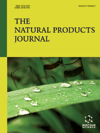- Home
- A-Z Publications
- Natural Products Journal, The
- Previous Issues
- Volume 6, Issue 3, 2016
Natural Products Journal, The - Volume 6, Issue 3, 2016
Volume 6, Issue 3, 2016
-
-
Therapeutic Applications of Crocus sativus L. (Saffron): A Review
More LessAuthors: Maryam Vahedi, Sumit Govil, Shailesh Kumar, Divya Shrivastava, Roghaye Karimi and Prakash S. BisenSaffron is an integral part of various traditional medicines containing several phytochemicals having disease preventing and health promoting properties. The antidepressant, cardio protective and chemopreventive properties of saffron can be attributed to its constinuent active phytochemicals and bioactive compounds like crocin, crocetin and safranal. Publicly available databases like NCBI-PubChem and ChEMB Read More
-
-
-
A Comprehensive Review on Pharmacognostical Investigation and Pharmacology of Typhonium trilobatum
More LessAuthors: Kuntal Manna, Bikash Debnath, Manik Das and Sarapynbiang MarweinEdible plants are vital in our diet and have ethno medicinal values as well. They are an essential source of food and highly beneficial for the maintenance of health and prevention of diseases. The genus Typhonium (Family: Araceae) is a leafy vegetable and comprises of about 69 species of tuberous perennial herbs. It is widely distributed in tropical region of India, China, Bangladesh, Burma, Siam, Ceylon, Malaysia and No Read More
-
-
-
Synthesis of Grafted Locust Bean Gum Using Vinyl Monomer and Studies of Physicochemical Properties and Acute Toxicity
More LessAuthors: Tapan K. Giri, Suraj Vishwas and Dulal K. TripathiObjective: The objective of the work was to synthesize polyacrylamide (PAAm) grafted locust bean gum (LBG) via conventional method using ceric ammonium nitrate (CAN) as free radical initiator to improve flocculation efficiency. Method: The effects of concentration of CAN, acrylamide (AAm), LBG, reaction time, and temperature on grafting were studied to determine the grafting percentage and grafting efficiency. The synthes Read More
-
-
-
A Novel Anticandidal Compound Containing Sulfur from Endophytic Fungus Emericella sp.
More LessAuthors: Shweta Mittal, Divya Shrivastava, Sumit Govil, Shailesh Kumar and Prakash S. BisenBackground: Endophtes live symbiotically in the tissues of host plants without causing visible harm. These endophytes produce not only the plant bioactive metabolites but also a host of unexplored structurally diverse natural products having biological activity. New niches may be explored for bioprospecting endophytes for the development of novel candidate molecules having industrial applications. Methods: The bioactive co Read More
-
-
-
Chemical Composition, Antimicrobial and Free Radical Scavenging Activities of Extracts from the Leaves of Desmodium adscendens
More LessBackground: Desmodium adscendens is a potential source of different phytochemicals that may be responsible for its numerous pharmacological properties. The aim of this study is to analyse the constituents of leaf extracts of Desmodium adscendens using Gas Chromatography-Mass Spectrometry, and evaluate the antimicrobial and free radical scavenging activities of the plant extracts. Methods: The dried and grind l Read More
-
-
-
Effect of Passion Fruit (Passiflora edulis f. flavicarpa deg.) Peel Flour on the Prognosis of Acute Pancreatitis after Overnutrition During Lactation
More LessBackground: Acute pancreatitis (AP) is an inflammation process that can affect the systemic inflammatory response syndrome, mainly in obese individuals. The passion fruit peel flour (PFPF) is rich in fibers that help to reduce cholesterol and blood glucose levels. Methods: In this study, AP was induced by 5% sodium taurocholate inoculation (biliopancreatic duct). The prognosis was evaluated after treatment with PFPF in ob Read More
-
-
-
Evaluation of the Organic Content of Jussara (Euterpe edulis Martius) Fruit Pulp Submitted to Slow vs Rapid Freezing
More LessBackground: Jussara (Euterpe edulis Martius) is a palm tree in the Arecaceae family that is native to the Atlantic forest in Brazil. The fruits are round and dark purple due to their anthocyanin content. They have similar sensorial and nutritional properties as açaí berries. However, they have been reported to have a higher concentration of anthocyanins than açaí. Traditionally, the fruits have been preserved by freezing them. Howe Read More
-
-
-
Phytochemical Screening, In vivo Anthelmintic and Anticonvulsant Activity of Cleome viscosa Linn Seeds Extract
More LessAuthors: Harpreet Singh, Amrita Mishra and Arun K. MishraBackground: In current era, plants are used worldwide to cure various ailments. There is an urgent need to search new plant derived bioactive agents that can be beneficial to cure helminthiasis. Therefore, we performed phytochemical screening, anthelmintic activity and anticonvulsant activity of Cleome viscosa Linn seeds. Methods: Paralysis time (PT) and death time (DT) evaluation method was used to evaluate anthel Read More
-
-
-
Evaluation of Physico-Chemical Properties of Dried Aloe Gel: Comparison among Hot Air, Microwave-Assisted and Hybrid Drying Processes
More LessAuthors: Arijit Das, Chandan Das and Animes K. GolderBackground: Aloe vera has been used as a medicinal plant for several hundred years. Aloe vera gel is a rich source of certain bioactive polysaccharides which are essential for immune-therapic activities. Aloe vera gel is prone to bacterial activities which could reduce its storage life due to high water content (97-99%). Drying is the main operation for the dehydration of aloe vera gel but it could significantly affect the Read More
-
-
-
Unravelling the Antioxidant Potential, Alpha-Glucosidase Inhibitory Activity and Phenolic Composition of Dendrocalamus strictus Plantations Generated Biomass Waste (Leaves)
More LessAuthors: Himani Pande, Brijesh Kumar and Vinay K. VarshneyBackground: Vast quantity of leaves as biomass waste is generated from Dendrocalamus strictus (DS) plantations and may have serious environmental impact from their disposal. One approach for management of this waste is the recovery of valuable compounds for industrial applications. Objective: Antioxidant capacity (AOXC) and α-glucosidase inhibitory activity (GIA) guided chemical examination of the leave Read More
-
Most Read This Month
Article
content/journals/npj
Journal
10
5
false
en


